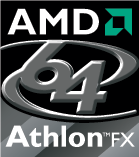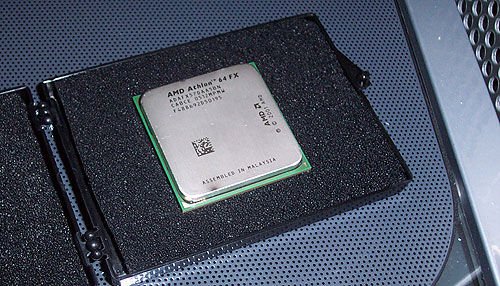FX-57 compared to FX-55

A table will give you a good overview of what's new in the San Diego core Athlon 64 FX, compared to the old Clawhammer core FX-55.
| AMD Athlon 64 FX-57 | AMD Athlon 64 FX-55 | |
| Core Codename | San Diego | Clawhammer |
| Die size | 115mm² | 193mm² |
| Manufacturing Process | 90nm SGOI @ AMD, Fab 30, Dresden | 130nm SOI @ AMD, Fab 30, Dresden |
| Thermal Design Power | 104 watts | |
| Transistor Count | ~114 million | ~105.9 million |
| Max processor current | 74.9A (1.388V Vmax at peak) | ~69.3A estimated |
| Standard Vcore | 1.35V to 1.40V | ~1.50V |
| External and memory controller frequencies | 2800MHz | 2600MHz |
| Level 1 cache sizes | 64KiB L1 Data + 64KiB L1 Instruction | |
| Level 2 cache size | 1024KiB data, non-mirrored | |
| Packaging Type | Organic µPGA, Socket 939 | |
| Maximum supported memory speed | 200MHz (DDR400/PC3200) | |
| Supported ISAs and ISA extensions | x86, x86-64, SSE, SSE2, SSE3, 3DNow! | x86, x86-64, SSE, SSE2, 3DNow! |
There's a few things to take note of. The higher current (Icc) helps transistors switch quicker, giving rise to a higher frequency (2800MHz) at a lower supply voltage (around 1.36V) for a given output power (the same 104 watts that FX-55 spits out). That output power means that FX-55's thermal solutions can be used with FX-57, so there's no change in the boxed processor cooler that FX-57 will ship with, and any validated FX-55 coolers on the market today will be happy keeping FX-57's heat output under control. San Diego is also some 60% of the size that Clawhammer is, in terms of die area, despite packing in more transistors. The die space savings 90nm affords are substantial.
San Diego brings SSE3 support to Athlon 64 FX for the first time, along with support for mismatched DIMM sizes in its memory controller, more efficient use of memory compared to Clawhammer and more performance from its data prefetcher, which pulls data out of system memory into the processor's caches, in advance of it being needed.
A lower supply voltage likely means a BIOS update for the majority of boards and board vendors will likely roll in FX-57 BIOS support with their Venice and Toledo 90nm changes. Basically a Clawhammer at 2800MHz with SSE3 and some memory controller and prefetcher tweaks, using around eight million more transistors to get there. The Clawhammer comparison is maybe a poor one overall, but as a means to get a grasp of performance and features it serves a purpose.
FX-57 therefore seeks to increase AMD's single-core performance lead that FX-55 created some eight months ago, with a clock bump, a move to 90nm SGOI and the latest core stepping of AMD's K8 Athlon 64 architecture.
That's what the CPU looked like before I shoved it cack-handedly into a mainboard, strapped a '55-validated 'sink to its heat spreader and benchmarked the bejesus out of it. Fancy having a peek at what AMD's Socket 939 flagship single-core CPU spat out, benchmark wise?










